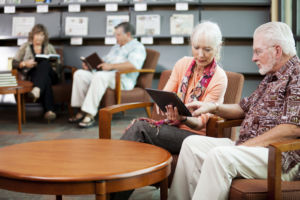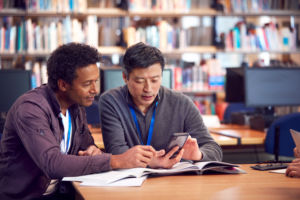The digital divide refers to the gap between those who have access to technology and internet (and everything that offers) and those who don’t. Like most inequities, this issue is nuanced. Causes include differences in education, income, geography, digital literacy, and more. And many people without access are likely to face more than one of those issues as barriers to getting connected.
More attention has been given to this issue over the past year as schools moved to remote learning in the face of the COVID-19 pandemic, but the digital divide is not limited to the needs of young students. According to Aging Connected, nearly 22 million seniors over age 65 lack wireline broadband access at home. In 2020, the gap that already existed for older adults was highlighted in a new way. That gap also became more important and more detrimental than ever. As rapid progress was made in online education, telemedicine, social connection, and more, access to and the ability to use technology to access important information, services, and wellbeing became more crucial. Without this access, many communities found themselves without the services they need, left behind as the rest of the world went online during the pandemic.

What can all of us with access do to address this issue? First, we can recognize that we are not alone in this fight. While the road to equal access for all is a long one, there are numerous organizations (and individuals) working to get people connected right now. Below, we highlight some of these organizations, all of which offer resources nationally. There are likely local non–profits and advocacy groups working to address issues specific to your community, and we encourage you to explore those resources as well.
We’ve also included a few ideas to get started at the end of this post, and you can get even more inspiration from our community stories featuring Tikvah for Parkinson’s and Rahul Kassel’s MacBryte company, both of which have worked to address issues of digital access in their communities.
Low-Cost Internet Service and Devices
Aging Connected partners with telecommunications companies, nonprofits, and public entities to bring low-cost internet options to older adults nationwide. By providing your zip code along with some additional information about your circumstances, you can see what internet and device offers are available to you.

EveryoneOn’s mission is to create social and economic opportunity by connecting low-income families to affordable internet service and computers and delivering digital skills trainings. This organization works in partnership with cable and wireless ISPs to connect low-income households. They also strive to make the resources easier to use through awareness building, digital training, and matching services.
ConnectHomeUSA is a program from EveryoneOn that works in partnership with public housing agencies, local government, internet service providers, and non-profit organizations to bridge the digital gap for HUD-assisted households.
The Emergency Broadband Benefit Program is a Federal Communications Commission (FCC) program that provides a temporary discount on monthly broadband bills for qualifying low-income households.
Digital Literacy
Senior Planet is a program from AARP that offers courses, programs, and activities to help seniors harness the power of technology to change the way we age. In addition to their online resources, they have six locations across the country that provide in-person programming (They are currently closed due to COVID-19).

For community leaders looking for ways to teach digital literacy, check out the Teaching Community Technology Handbook by Allied Media Projects, as well as the Senior Planet Low-Density Communities (LDC) pilot program from OATS.
Advocacy
Interested in being part of the solution? Explore these resources to learn more about advocating to close the digital divide once and for all:
OATS (Older Adults Technology Services)
NDIA (National Digital Inclusion Alliance)
Some Ideas to Get Started
Create a digital inclusion coalition in your area to help inspire advocacy, alignment, and action at the community and policy level to address digital inclusion. Or look to see if there are cross-sector groups taking this work on, especially in relation to access for school-aged people related to the COVID-19 crisis.
Start a digital literacy class at your local library or other community gathering place. Advertise using flyers and word–of–mouth networking to ensure people without access can find out about it.

Research the systems that are creating barriers to access in your area. Are there infrastructure laws? Job/income loss? A lack of awareness? Knowing more about these issues can help you know where to begin and what tangential areas to advocate for.
Explore in-kind partnerships. Are there local businesses or organizations that are interested in addressing this issue and could help by donating gently used technology or opening their doors to share their internet or workspace with people who need access during the day?
Look into programs/emergency funding available through the CARES Act. There may be funding available to you now that can be used towards programs like this one in Nevada aimed at providing tablets to people ages 60 and up.

